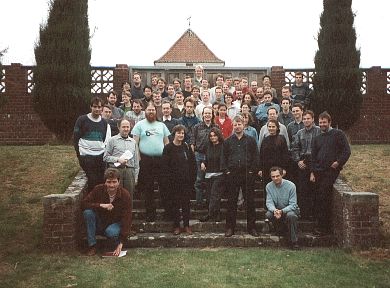SUMMER SCHOOL
Geometry of quiver-representations
and preprojective algebras


10 - 17 September 2000
Sussex - England
Organizers:
Karin Erdmann (Oxford)
erdmann@maths.ox.ac.uk
William Crawley-Boevey (Leeds)
w.crawley-boevey@leeds.ac.uk
Christof Geiß (UNAM)
christof@math.unam.mx
The Summer School took place from 10 to 17 September 2000 at the Isle of Thorns, a conference center of the University of Sussex, south of London and in easy reach of Gatwick Airport.
It followed the tradition of previous summer schools in representation theory. In the first half the participants gave lectures on the following topics. In the second half the following experts spoke:
The Summer School was particularly aimed at students working for a Ph.D. degree, or those with a recent Ph.D., but it was also open to more experienced mathematicians. It was one of a series of four Summer Schools funded by the European Union under the TMR scheme. For details of the other ones, see http://www.mathematik.uni-bielefeld.de/~sek/summerseries.html. Additional funding was provided by the London Mathematical Society and by EPSRC.
Sunday 10 September was the arrival day. From Monday to Thursday the participants gave the lectures that they had prepared in advance. From Friday until Sunday lunch time there were lectures by experts. Departure was be after lunch on Sunday 17 September.
We need to begin with just a few easy definitions. A quiver is a finite directed graph, e.g.

and a representation of the quiver consists of a collection of vector spaces and linear maps arranged in the same shape as the quiver, so with a vector space for each vertex and a linear map for each arrow. The dimension vector of a representation is the vector whose i-th component is the dimension of the vector space at the i-th vertex.
The study of representations of quivers encompasses many problems in linear algebra, for example Kronecker's classification of matrix pencils [Kre], and the problem of classifying quadruples of subspaces in a vector space, solved by Gelfand and Ponomarev [GP]. It has gradually become clear that many problems in other parts of representation theory, particularly those involving indecomposable representations, can be formulated and studied in terms of representations of quivers (see for example the books by Benson [Be] and Gabriel and Roiter [GR]).
To study the 'geometry of quiver-representations' means to study the algebraic variety which classifies the representations of a quiver of a fixed dimension vector, as well as related varieties, including moduli spaces in the sense of geometric invariant theory.
In this context there is work by Schofield [S1] aiming to understand the properties of a 'sufficiently general' representation of the quiver, and work by Riedtmann [Rie1], Bongartz [Bo1, Bo3] and Zwara [Z1, Z2, Z3], studying how representations can degenerate into other representations.
The varieties which arise are often related to Grassmannians and flag varieties, and there are also connections with more classical mathematics, like Schubert calculus (see for example [F1, F2, CB2]).
The first aim of the Summer School is to understand this geometry and related theory.
The behaviour of the representations of a quiver turns out to be controlled by the Lie algebra whose graph is obtained from the quiver by forgetting the directions of the arrows. If the graph is a Dynkin diagram (e.g. E6 as illustrated) this is a finite-dimensional simple Lie algebra; in general it is a Kac-Moody algebra. The corresponding quantum group is also involved.
At a purely combinatorial level these connections appeared in work of Gabriel [G] and Kac [Ka1, Ka2], who showed that the dimension vectors of indecomposable representations of the quiver correspond to the positive roots for the Lie algebra. A more intimate connection was observed by Ringel [Rin1] in the context of Hall algebras, and later Lusztig [Lu1, Lu3] used similar ideas in the context of perverse sheaves to construct his 'canonical bases' of quantum groups.
The second aim of the Summer School is to understand these ideas in a more elementary geometric setting. One can define certain varieties which are related to the variety of representations of a quiver, but independent of the directions of the arrows. These varieties can also be considered as varieties of representations of certain 'preprojective algebras' introduced by Gelfand and Ponomarev (see [Rin2]). In his work on canonical bases, Lusztig studied the 'nilpotent' parts of these varieties, and now Kashiwara and Saito [KS], have used the nilpotent parts to give a geometric construction of crystal bases for quantum groups. There are also moduli spaces in this setting. Special cases arose originally in connection with Kleinian singularities and asymptotically locally Euclidean hyper-Kähler manifolds [Krh, CS] and instantons on such spaces [KN]. More general ones, called 'quiver varieties' by Nakajima, have been used by him to construct the integrable representations of Kac-Moody algebras [Na1, Na2].
This page is maintained by
William Crawley-Boevey
Last modified 28 February 2002.